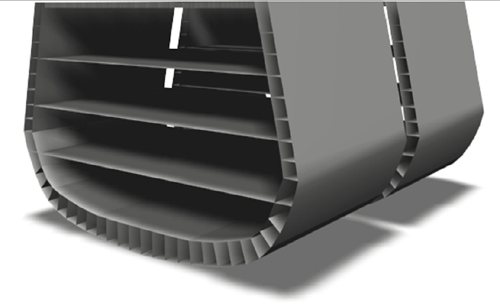Hull Life Assurance Thrust
Overview
The Hull Life Assurance (HLA) thrust is focused on improving
the combat effectiveness of surface ships through technological
advances in structural design. Results of the Hull Life Assurance
thrust will provide:
- Design solutions for less susceptible, more survivable
ships with reduced life cycle costs. The focus is on developing
non-magnetic hulls and low-observable topsides.
- An increase in the phenomenological understanding of the
physical behavior of marine systems in order to transition
towards simulation-based design and accelerate the insertion
of technology into new platforms.
HLA can be divided into two areas: hull structures and topside
structures.
Hull Structure Technology
Welded, stiffened, steel ship hulls have been the standard
construction method for Navy ships for the past 60 years.
Recent Navy interest in balanced, total-spectrum signature
reduction as well as the need for life cycle cost savings
has resulted in the development and consideration of alternative
materials and geometries for use in hull applications. Initiatives
include:
- Stainless Steel Advanced Double Hull (SSADH) —
Combatant hulls fabricated of appropriate stainless-steel
alloys in the Advanced Double Hull (ADH) configuration
offer potential benefits in terms of significantly
reduced signatures, improved affordability, and reduced
vulnerability. The work includes:
- crevice/crack corrosion concerns
- material fatigue issues
- strain rate effects
- optimal welding processes
- enhanced survivability concepts
- structural acoustic performance assessment
- large-scale testing and demonstrations
- shipyard producibility
|

Computer
model of Advanced Double Hull
|
- Composite Primary Hull — Composite materials offer
an alternative approach to hull design, with benefits that
include lower magnetic signatures and potentially lower
life cycle costs. The current focus is on assessing composite
hull structures subjected to UNDEX loading and developing
failure prediction tools and design guidelines for composite
structural joints and details.
- Hybrid Hull — Hybrid steel/composite
options are also being explored. This offers signature and
cost benefits similar to those available from the parent
technologies but with the added benefit of being able to
selectively tailor structural solutions to specific areas
on the ship. For example, combining a SSADH mid-body with
a composite bow and stern would provide a reduced-magnetic-signature
hull with a method to economically manufacture the complex
geometry associated with the bow/stern shapes being considered
for new combatants. An alternative hybrid approach being
investigated consists of attaching composite panels to a
steel framework in order to facilitate simple manufacture
and repair.
Topside Structures
The primary focus of the Topside Structures area is to develop
and demonstrate technologies that enable future combatant
topsides to achieve their specified performance levels in
the areas of RF and IR signatures, topside weight, and life
cycle costs. Initiatives include:
- Reliability-Based Design —
This initiative will develop the ability to statistically
define the probability of survival under environmental loads
for intact or damaged hulls over the operational lifetime
of the ship.
- Composite Structural Performance
— This initiative will establish the thermo-mechanical
behavior of polymer matrix composite structures in the marine
environment. It will provide models for the prediction of
the response of composite structures to static, dynamic,
and cyclic loading in severe environments, including extremes
of temperature, moisture, seawater, and hydrostatic pressure.
- Structural Analysis Codes —
This initiative will advance the phenomenological understanding
of the physical behavior of marine systems and platforms
and advance related predictive and simulation capabilities.
- Analytical Methods to Predict Weapons
Effects — This initiative will develop an understanding
of the failure modes and mechanisms of current and advanced
ship structures subjected to underwater and air-detonated
weapons.
- Basic Research Descriptions For:
Program Officer
Phone: 703-696-0813
E-mail: 334HL@onr.navy.mil
|

